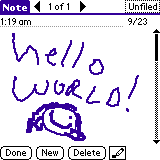Starting with Palm OS version 5.2, Palm created customized versions of the common PIM application. Some new features have been added, e.g. support for Address categories, Ringtone associations to users, longer memo texts, etc.. They were also renamed to reflect designations from Microsoft Outlook, thus Address became Contacts, Datebook became Calendar, Memo Pad became Memos and To do list became Tasks.Blazer is a web browser for Palm handhelds. The versions 1.0 and 2.0 run on Palm OS 3.1 or higher handhelds, but they needed a proxy server which has been shut down, so they can no longer be used. Version 3.0 is used on the Treo 600 smartphone. The current version of Blazer is Blazer 4.5, which is compliant with most major standards. It is generally bundled with newer smartphones and newer Palm devices capable of accessing the Internet.
Palm's Note Pad can be used for quick drawings. With neat handwriting, 20-30 words will fit on one page; for more text, Memo Pad is the better choice. There are three sizes of pen width, plus an eraser and a background color change feature in some models. It is possible to draw a very simple map. The more "advanced" desktop version saves the Memo pad drawings to the desktop.As of 2006, most new Palm handhelds include Photos, which creates a digital photo album used to view pictures on a Palm OS device. As with all the other photo programs, photos can be beamed to other mobile devices. Each photo can be labeled and organized into separate photo albums. A slideshow can also be shown for a specific album, and each photo in the album will be shown full screen.
Photos can be edited with the Palm Photos PC software (Windows only), and when the photos are transferred to the handheld they will contain all changes made to the photo.The Palm Photos software is available in the Zire 71, Tungsten C, Tungsten E, Tungsten T2, Tungsten T3 and several others.With the support for Video, Palm Photos was later renamed to Media and even later to Pics& Videos.Some models feature the ability to make voice recordings which are synced using the Voice conduit and can be viewed on a desktop with the Voice Memo application which is part of the Palm Desktop Suite.
